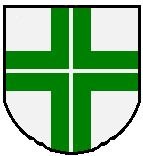Gammadium
As gammadium (from ancient Greek τετραγαμμάδιον - four gamma, Latin gammadium or crux gammata - gamma cross; French croix gammée) a cross is referred to in heraldry that is formed from a common cross, which is vertically from a pole and horizontally from a bar , both in thread size, centered. It is usually a herald image .
Originally, Byzantine robes and Greek chasuble were decorated with decorations similar to the Greek capital letter gamma " Γ ". For this purpose, four gamma letters were placed symmetrically in a cross. Book corners were also decorated with gammas. Soon four letters " F ", slightly modified, were put into a gammadium and called a gymnast's cross . This term is common in the gymnastics movement. The four letters stand for “ fresh, pious, happy, free ”.
literature
- Jacob Grimm, Wilhelm Grimm: German Dictionary , German Academy of Sciences in Berlin, Academy of Sciences in Göttingen, published by S. Hirzel in 1854
- Heinrich Otte , Otto Fischer: Archaeological Dictionary , Reprint-Verlag, Leipzig 2001; ISBN 3-8262-1513-3
Web links
- Gammadium on the Heraldry Wiki
